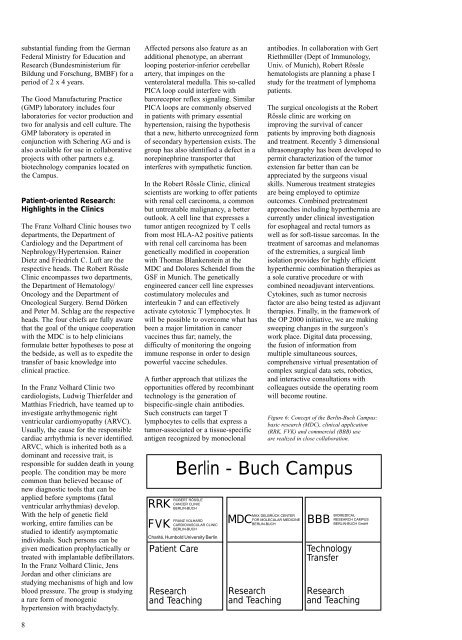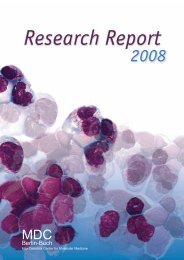You also want an ePaper? Increase the reach of your titles
YUMPU automatically turns print PDFs into web optimized ePapers that Google loves.
substantial funding from the German<br />
Federal Ministry for Education and<br />
<strong>Research</strong> (Bundesministerium für<br />
Bildung und Forschung, BMBF) for a<br />
period of 2 x 4 years.<br />
The Good Manufacturing Practice<br />
(GMP) laboratory includes four<br />
laboratories for vector production and<br />
two for analysis and cell culture. The<br />
GMP laboratory is operated in<br />
conjunction with Schering AG and is<br />
also available for use in collaborative<br />
projects with other partners e.g.<br />
biotechnology companies located on<br />
the Campus.<br />
Patient-oriented <strong>Research</strong>:<br />
Highlights in the Clinics<br />
The Franz Volhard Clinic houses two<br />
departments, the Department of<br />
Cardiology and the Department of<br />
Nephrology/Hypertension. Rainer<br />
Dietz and Friedrich C. Luft are the<br />
respective heads. The Robert Rössle<br />
Clinic encompasses two departments,<br />
the Department of Hematology/<br />
Oncology and the Department of<br />
Oncological Surgery. Bernd Dörken<br />
and Peter M. Schlag are the respective<br />
heads. The four chiefs are fully aware<br />
that the goal of the unique cooperation<br />
with the <strong>MDC</strong> is to help clinicians<br />
formulate better hypotheses to pose at<br />
the bedside, as well as to expedite the<br />
transfer of basic knowledge into<br />
clinical practice.<br />
In the Franz Volhard Clinic two<br />
cardiologists, Ludwig Thierfelder and<br />
Matthias Friedrich, have teamed up to<br />
investigate arrhythmogenic right<br />
ventricular cardiomyopathy (ARVC).<br />
Usually, the cause for the responsible<br />
cardiac arrhythmia is never identified.<br />
ARVC, which is inherited both as a<br />
dominant and recessive trait, is<br />
responsible for sudden death in young<br />
people. The condition may be more<br />
common than believed because of<br />
new diagnostic tools that can be<br />
applied before symptoms (fatal<br />
ventricular arrhythmias) develop.<br />
With the help of genetic field<br />
working, entire families can be<br />
studied to identify asymptomatic<br />
individuals. Such persons can be<br />
given medication prophylactically or<br />
treated with implantable defibrillators.<br />
In the Franz Volhard Clinic, Jens<br />
Jordan and other clinicians are<br />
studying mechanisms of high and low<br />
blood pressure. The group is studying<br />
a rare form of monogenic<br />
hypertension with brachydactyly.<br />
8<br />
Affected persons also feature as an<br />
additional phenotype, an aberrant<br />
looping posterior-inferior cerebellar<br />
artery, that impinges on the<br />
venterolateral medulla. This so-called<br />
PICA loop could interfere with<br />
baroreceptor reflex signaling. Similar<br />
PICA loops are commonly observed<br />
in patients with primary essential<br />
hypertension, raising the hypothesis<br />
that a new, hitherto unrecognized form<br />
of secondary hypertension exists. The<br />
group has also identified a defect in a<br />
norepinephrine transporter that<br />
interferes with sympathetic function.<br />
In the Robert Rössle Clinic, clinical<br />
scientists are working to offer patients<br />
with renal cell carcinoma, a common<br />
but untreatable malignancy, a better<br />
outlook. A cell line that expresses a<br />
tumor antigen recognized by T cells<br />
from most HLA-A2 positive patients<br />
with renal cell carcinoma has been<br />
genetically modified in cooperation<br />
with Thomas Blankenstein at the<br />
<strong>MDC</strong> and Dolores Schendel from the<br />
GSF in Munich. The genetically<br />
engineered cancer cell line expresses<br />
costimulatory molecules and<br />
interleukin 7 and can effectively<br />
activate cytotoxic T lymphocytes. It<br />
will be possible to overcome what has<br />
been a major limitation in cancer<br />
vaccines thus far; namely, the<br />
difficulty of monitoring the ongoing<br />
immune response in order to design<br />
powerful vaccine schedules.<br />
A further approach that utilizes the<br />
opportunities offered by recombinant<br />
technology is the generation of<br />
bispecific-single chain antibodies.<br />
Such constructs can target T<br />
lymphocytes to cells that express a<br />
tumor-associated or a tissue-specific<br />
antigen recognized by monoclonal<br />
RRK<br />
FVK<br />
antibodies. In collaboration with Gert<br />
Riethmüller (Dept of Immunology,<br />
Univ. of Munich), Robert Rössle<br />
hematologists are planning a phase I<br />
study for the treatment of lymphoma<br />
patients.<br />
The surgical oncologists at the Robert<br />
Rössle clinic are working on<br />
improving the survival of cancer<br />
patients by improving both diagnosis<br />
and treatment. Recently 3 dimensional<br />
ultrasonography has been developed to<br />
permit characterization of the tumor<br />
extension far better than can be<br />
appreciated by the surgeons visual<br />
skills. Numerous treatment strategies<br />
are being employed to optimize<br />
outcomes. Combined pretreatment<br />
approaches including hyperthermia are<br />
currently under clinical investigation<br />
for esophageal and rectal tumors as<br />
well as for soft-tissue sarcomas. In the<br />
treatment of sarcomas and melanomas<br />
of the extremities, a surgical limb<br />
isolation provides for highly efficient<br />
hyperthermic combination therapies as<br />
a sole curative procedure or with<br />
combined neoadjuvant interventions.<br />
Cytokines, such as tumor necrosis<br />
factor are also being tested as adjuvant<br />
therapies. Finally, in the framework of<br />
the OP <strong>2000</strong> initiative, we are making<br />
sweeping changes in the surgeon’s<br />
work place. Digital data processing,<br />
the fusion of information from<br />
multiple simultaneous sources,<br />
comprehensive virtual presentation of<br />
complex surgical data sets, robotics,<br />
and interactive consultations with<br />
colleagues outside the operating room<br />
will become routine.<br />
Figure 6: Concept of the Berlin-Buch Campus:<br />
basic research (<strong>MDC</strong>), clinical application<br />
(RRK, FVK) and commercial (BBB) use<br />
are realized in close collaboration.<br />
Berlin - Buch Campus<br />
ROBERT RÖSSLE<br />
CANCER CLINIC<br />
BERLIN-BUCH<br />
FRANZ VOLHARD<br />
CARDIOVASCULAR CLINIC<br />
BERLIN-BUCH<br />
Charité, Humbold University Berlin<br />
Patient Care<br />
<strong>Research</strong><br />
and Teaching<br />
<strong>MDC</strong> BBB<br />
MAX DELBRÜCK CENTER<br />
FOR MOLECULAR MEDICINE<br />
BERLIN-BUCH<br />
<strong>Research</strong><br />
and Teaching<br />
BIOMEDICAL<br />
RESEARCH CAMPUS<br />
BERLIN-BUCH GmbH<br />
Technology<br />
Transfer<br />
<strong>Research</strong><br />
and Teaching

















